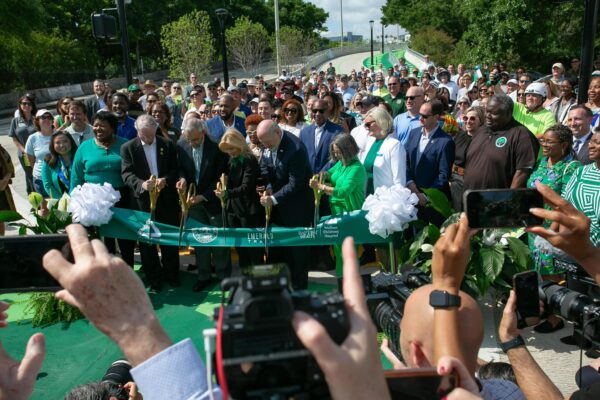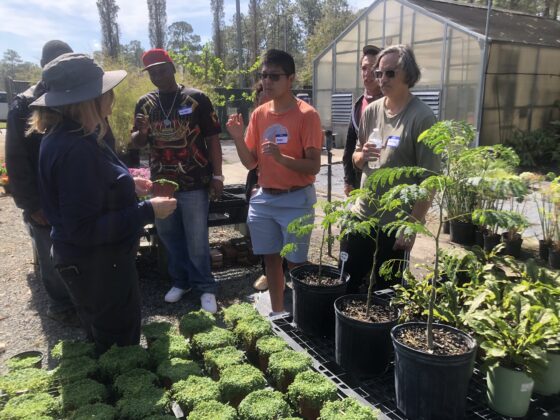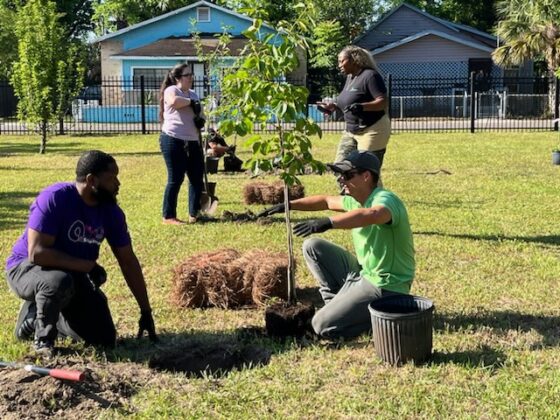Jacksonville’s downtown neighborhoods were once home to vibrant African American communities, such as LaVilla, known as the “Harlem of the South.” However, decades of divestment through redlining and the construction of an elevated freeway system in the 1970s systemically disconnected these communities from social, health, and economic opportunities. Of the 79,000 people that call these communities home, 34% live below the poverty line and almost 10% are unemployed, double the unemployment rate in Duval County as a whole.

The Emerald Trail initiative, spearheaded by Groundwork Jacksonville (GWJax) in partnership with the City of Jacksonville, is a multi-million dollar investment in 34 miles of parks, trails, and green spaces, with the potential to repair the harms caused by past housing and zoning politics, reconnect Jacksonville’s urban core, and create a more equitable and thriving city for all residents. However, that’s only possible if the community members residing in the neighborhood benefit from the environmental impacts of green spaces and the economic opportunities associated with the trail’s construction and long-term stewardship.
To help bridge the connection between residents and emerging job opportunities, GWJax established the Emerald Trail Stewards (ETS) Pre-Apprenticeship Program in collaboration with a group of partners, including the Florida Nursery Growers and Landscape Association (FNGLA), University of North Florida Botanical Gardens, Liberty Landscape Supply, and CaraeerSource Northeast Florida, and with funding from Groundwork USA’s Land Use Innovation Initiative. Through this program, residents can receive industry-recognized credentials, hands-on experience and training, and career navigation support to translate this experience into living wage employment.
Janet Reagor, COO of GWJax, explains, “In addition to building a world-class trail, we wanted to maintain it. There’s a real need for more people working in the landscape space and there’s a need for jobs in the neighborhoods where we’re working. With our mission of bringing economic opportunities to neighborhoods along the trail, we felt like [the ETS program] was a win-win.”

The first round of the program was six months of paid workforce training, providing fifteen working-age community members with the theoretical and hands-on experience necessary to earn certifications in landscape maintenance and horticulture. Before the program started, GWJax led a grassroots outreach effort, including attending community meetings, posting on social media, and promoting to their partners’ networks, to reach a wide audience interested in learning about and pursuing a career in horticulture and landscaping. Participants ranged in age from college students to semi-retired folks with diverse backgrounds, career paths, and perspectives.

The curriculum, based on FNGLA’s certification courses, combined classroom learning, hands-on field experience, and soft-skill and professional development, and supported participants with their certification exams. GWJax paid participants $15/hour (above FL’s minimum wage) and hired an ETS Program Manager to help them stay on track and access any necessary wrap-around services throughout the six months.
The course itself is just the start. In an industry with upfront training requirements and frequent turnover, the ETS program is structured to give participants a foundation in the field. “This is not just a job,” Janet said. “We’re hoping that the program really provides a career pathway for participants.” GWJax is committed to helping ETS participants find their next step, hiring graduates directly, working to place them in full-time employment with partner organizations or apprenticeships, or helping them enroll in other education programs to continue building their hands-on skills. GWJax hosted a hiring event with local employers to expose participants to a range of opportunities open to them with their new credentials. From the first cohort, two graduates now work for GWJax as Emerald Trail Stewards (and GWJax is sponsoring their ongoing training and certifications), one was hired at Liberty Landscape, and several are continuing to pursue additional certifications.
what comes next?
GWJax collected feedback on the ETS apprenticeship from cohort participants and the program committee, which met monthly throughout the six months of the program. The response was overwhelmingly positive. But participants found the part-time schedule challenging because they weren’t always able to fill the gaps with other paid opportunities and they wanted more hands-on work experience. The program committee also discussed the difficulty of recruiting participants in a short time frame.

In response, GWJax is condensing the curriculum into fewer weeks to make the program full-time, increasing the time spent doing fieldwork and demo projects, and leaving a longer runway for participant recruitment upfront. In the next round, GWJax wants to reach more residents coming out of high school who may be interested in going directly into the workforce with industry certifications already in hand. While GWJax works to secure funding for a second round of the ETS program, the team is solidifying partnerships with more landscape companies, contractors, and employers, including the City of Jacksonville’s Parks Department (the largest employer in the city), who are always looking for certified landscape and horticulture professionals. They hope to place 100% of future ETS graduates in full-time jobs or apprenticeships.
These changes will strengthen the program moving forward, allowing GWJax to continue building a local workforce prepared to steward the Emerald Trail, while providing good job opportunities for residents whose economic circumstances have been shaped by discrimination – truly a win-win for all.
To learn more, visit Groundwork Jacksonville.
The Land Use Innovation Initiative, a multi-year investment in innovation, community leadership, and land revitalization, is made possible through a joint partnership between NPS-Rivers, Trails, and Conservation Assistance Program, the EPA’s Office of Brownfields and Land Revitalization, and Groundwork USA.
